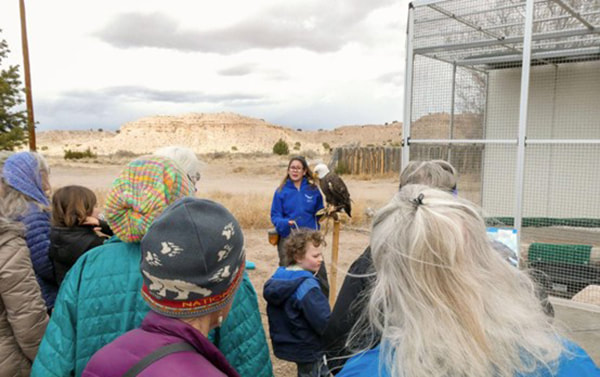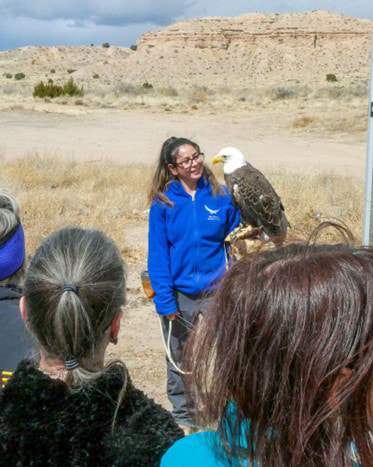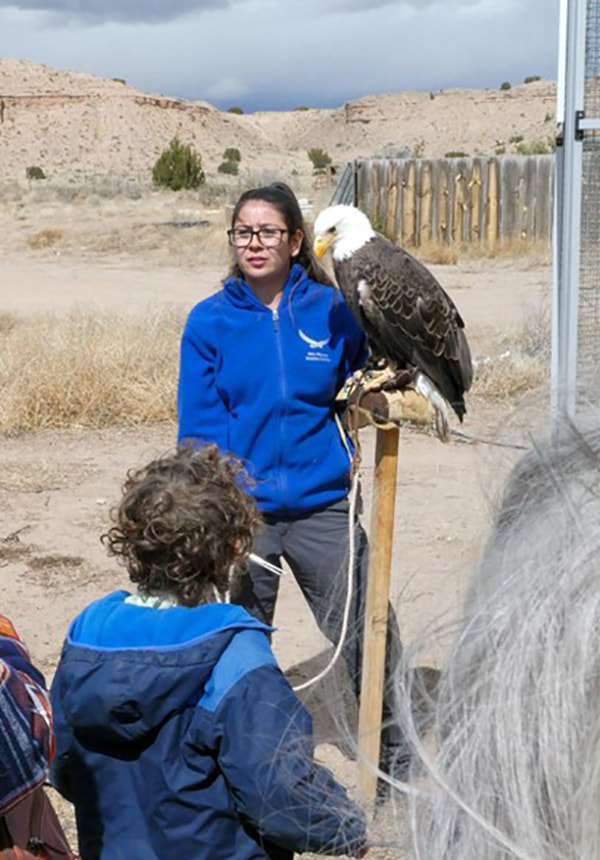|
`Jessica Rath Maybe you remember that the Wildlife Rehabilitation Center in Espanola had a Discovery Day on Saturday, March 11th. The Center is such a fantastic source of research and exploration in our area, and their work with injured wildlife is so much appreciated, that we wanted to follow up with a deeper look. So, we reached out to Ambassador Animal Specialist Raelynn Archuleta who kindly agreed to an interview with me. It was a pleasure to meet with a young person who is enthusiastic about her job. Clearly, Raelynn’s dedication to the animals she cares for is 100%. She grew up in El Rito and got a Bachelor's in Wildlife Fisheries Conservation Ecology from New Mexico State University’s main campus in Las Cruces. “When I graduated in 2021, I started as a volunteer here at the New Mexico Wildlife Center, mostly while I was looking for jobs. Then I decided to do the internship that was offered. After that, I got hired as part time staff and finally full time staff as this is what I really wanted to do,” she told me. “I've always been interested in wildlife, ever since I was little.” I asked her about the animals at the Center; are there any endangered species? “The walkabout path that we will visit shortly hosts our ambassador animals. They are non-releasable, mostly due to human impact, human imprints, and because of really bad injuries that they had. Some of our injury ambassador animals cannot be released because it can be fatal. Our hospital site can rehabilitate and release animals whenever that’s possible and is closed to the public. Manchado ( a Mexican Spotted Owl) came to us in 1998. He was found on a highway in the mountains of south central New Mexico, most likely hit by a car. He had a serious head injury. Then, during care, one of the rehabilitators noticed that cataracts had developed in one of his eyes from the injury, rendering him unreleasable. There are less than 2500 Mexican Spotted Owls in the United States and they are listed federally as a Threatened Species. This makes Manchado a rare and unique Ambassador Animal for his imperiled species." J.R.: What exactly is a human imprint? R.A.: Unfortunately, once a bird imprints on whoever feeds it first, this becomes irreversible. We have a couple of new human imprint animals here. People think that they're doing the right thing but actually they are doing the bad thing. When you see an injured animal, you should not talk to it or feed it. You should call the nearest wildlife rehabilitation center as soon as you can. Once an animal gets imprinted, it can’t be reversed. If you feed it from when it’s a baby, it will imprint you and think that you're its mom. It won't try and feed by itself. Because we’re humans and not birds, we can't really teach them their natural behavior like their actual mother would. J.R. That's good to point out. We tend to think we’re doing the right thing – there's a sick bird and you feel like you can help it. But that's a bad thing. R.A. That's also why there are a lot of signs, like, don't feed the wildlife. Once one person feeds it, more people are going to feed it. And that's when the animal is going to associate people with food. And that's when human and animal conflicts start happening. J.R.:Let me ask you about Dyami: How did he become an ambassador here? What is his history? R.A.: “Dyami” is Native American for “Eagle”. He came to us from Virginia in 2015, where he had fallen out of a nest as an eaglet. The previous vets who took care of him found out that he had developed cataracts at a young age. They thought it might have been a genetic thing. He also had a wing injury, probably from falling out of the nest. After several surgeries and physical therapy it was determined that his flight capabilities were permanently limited.That’s why he was deemed non-releasable. He was placed with the New Mexico Wildlife Center as an Ambassador Animal in 2017. And after he got transferred to us, after about a year and a half, he got beat up by a rat! We don’t know exactly how it happened, but the rat did some serious damage to him. He went back to the hospital, and when I started volunteering, he was doing recovery there, and that’s how we first met. When I became an intern he was released from the hospital and put into a new enclosure. I let him recuperate and settle in a bit. The previous coordinator had let me do some animal care, and she saw a connection that we had. I was soft-talking him, I had never been the “bad” person, so I started with him learning to re-trust humans. He took small baby steps, but we both learned from each other. To be able to present him on this last Discovery Day it took almost a year of trusting and bonding with him. When I was here as an intern I came at least three times a week for eight hours. When I became a seasonal worker, I was here five days a week for eight hours. Same thing with full-time, working 40 hours a week. I mostly spend an hour at a time training with him, associate him with choice base training, positive reinforcement, and to gain his trust. He is about eight years old. That’s still pretty young. Bald eagles normally don’t get their white heads until their fifth to seventh year. He’s not really “bald” – this comes from an Old English word “bala”, which means "white patch, blaze". J.R.:How old can Bald Eagles get? R.A.: Bald eagles’ lifespan in human care is 40+ years. In the wild, it is 20 – 30 years if that, because they lead a dangerous life, fighting for food and shelter, finding a mate. Also, Bald Eagles were endangered due to lead poisoning and pesticides. J.R.:What is your relationship with him? Is there a loving connection? R.A.: We don’t use the word “love”; they’re not domesticated, not like pets. It’s more like a trust-bond. He doesn’t necessarily love me but he trusts me. He recognizes me. It’s the first big animal I care for as a trainer, and we passed several milestones that have been recognized – this made me very emotional! More than him! [She chuckles]. J.R.: This must feel very special, to have a wild animal trust you – must make you feel good. R.A.: Yes, especially in our training: when he does something I know he can do, that’s really great. He does have his bad days too, when he just doesn’t want to do anything. Like today, when it’s cold and wet. So then we’ll do some positive choice base training, for example: if he comes and sits down on my glove and takes some treat from me I’ll call that a win for today. J.R.: Is the training for stimulation, to give him exercise? R.A.: Food is his main motivator, he’s a wild animal: he knows that if I do this, I’ll get a reward. We don’t use any negative reinforcement. We use LRS – Least Reinforcement Scenario. Training is also for educational purposes, and for outreach. And to get him physically moving. For if they just sit there, their health and QOL (Qhality of Life) begins to decrease. J.R.: What does he eat? None of our animals get live prey. We mimic what he would eat in the wild. Mice, voles, quails, chicks, and rabbits – cut up. But bald eagles mostly eat fish, they will steal the fish an osprey has caught! They’re scavengers too, if it’s already dead – they eat it because it saves them work. J.R.: What are your future plans? R.A.: This job is a door-opener, eventually I’d like to work with bigger exotics, but I want to get as much experience from here as I can. I envision zoos, aquariums; somewhat bigger facilities. We continued our conversation at the eagle enclosure. R.A.: His flight-ability is limited. He had a broken left wing when he was found. His high-soaring days were clearly over. He still can move and fly, he can do various hops, like a helicopter effect: he goes up and down.
Although his sight is compromised because of the cataract, his eyesight is still a lot better than a human's. Falcons and hawks have the greatest eyesight. Vultures are the kings of smell. They can smell carrion, a freshly dead animal from one to five miles in the air. We've been building up slowly for Discovery Day last weekend, just having a couple of visitors, a couple of kids. If he doesn’t want to come out, I will let him be; I won’t force him. He feels safer when there’s a barrier between him and me and the public. If I would force him to do something, that would break our trust. We use “Big Eagle” gloves: they use us as a perch, for safety precautions due to the talons. And he’s heavy – he weighs as much as a gallon of milk, so I have a stick for my arm to rest on. If I start shaking, he’d shake too, which would make him nervous. All birds of prey see colors the way humans can. Full spectrum, also some ultraviolet light. ***************** On our way back to the office, Raelynn pointed out some other ambassador animals: various falcons and hawks, owls, a vulture. They all can be “adopted” (meaning, sponsored): please visit the Wildlife Center's website if you want to connect with one of these magnificent animals! And our best wishes to Raelynn for all her future endeavors.
1 Comment
Birgitte
3/24/2023 08:53:17 am
Thank you, Jessica!
Reply
Your comment will be posted after it is approved.
Leave a Reply. |
Submit your ideas for local feature articles
Profiles Gardening Recipes Observations Birding Essays Hiking AuthorsYou! Archives
September 2025
Categories
All
|



 RSS Feed
RSS Feed